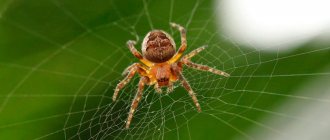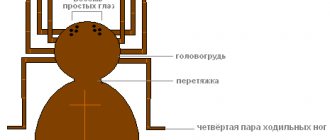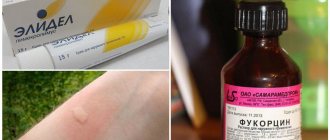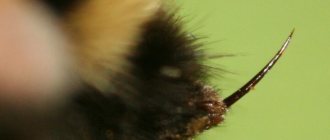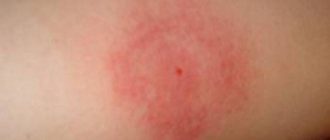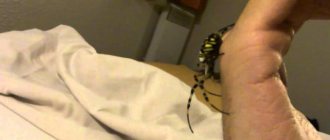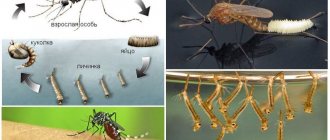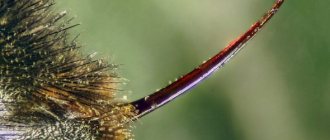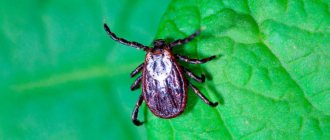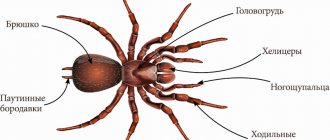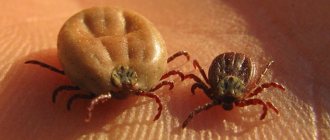Description of appearance
You can meet the cross in the forest, garden, field, in the yard among outbuildings. The spider loves a quiet place, protected from sunlight. During the day it sits motionless on the web or hides in a secluded place.
The size of females is no more than 1 cm, males are always smaller. The body is painted in brown and gray tones of different shades.
On a note!
On the abdomen there is a pattern in the form of a cross of white, yellow, orange spots and stripes. For this reason, the spider got its name.
The legs are long, powerful, attached to the cephalothorax. The number of legs, like all types of spiders, is 8. The abdomen is convex, oval in shape. In front of the head are strong chelicerae and pedipalps. With chelicerae, the predator kills the prey, inflicts bites, and injects poison. Pedipalps are movable tentacles. With them the spider grinds, crushes, grinds food, and holds prey.
Crossworts belong to the orb weaver family. They build trapping nets, wait for prey, sitting on the web or hanging in close proximity. You can often find a spider in the center of your creation in an "X" pose. It weaves threads around plants, grass, branches of trees, shrubs, and leaves.
Is the cross spider dangerous for humans?
The common spider or common spider is very common in nature. It can be observed on the banks of rivers, lakes, wet meadows, forests, as it loves damp places.
Belongs to the orbweed family. It is believed that this representative of the genus is a hermit and does not like arthropods of other species. Is the cross spider dangerous for humans? This question is in every person’s head, and we will try to give a detailed answer to it.
Let's take a closer look at what it is, what its features are, and what danger it poses to humans.
Features of the view
The cross or crusader does not choose a specific continent for its habitat according to any parameters; it lives everywhere.
Appearance of an adult
Based on the description of the appearance, everyone can determine that at least once in their life they have met the bearer of this sign on the back, but not everyone knows what to expect from him.
The insect got its name precisely because of its simple coloring. On its back there are several light spots that form something similar to a cross. The tonality of its color depends on its location.
That is, for example, if the spider is in direct sunlight, then its color fades and becomes pale brown; if in shaded thickets, then it is dark brown. This feature saves the spider from pests, which can be birds or other insects, for example, flies that can lay eggs directly into the body of the crusader.
Cross on the hand
The dimensions depend on the gender of the adult, that is, the male reaches up to 10 mm, and the female up to 20 mm. some females reach 26 mm in length. In the short life of a spider, molting occurs, a period when the chitinous cover changes. It is at this time that the body grows.
On the small head there are two pairs of black eyes, which is very typical for arachnids. This feature helps the insect quickly orient itself when it sees a prey. But the spider cannot clearly see its enemy or food; it reacts only to movement or shadows, the outlines of objects. The body of the insect is densely covered with small hairs, which play the role of organs of touch; they sense any vibration occurring around them.
See also - Brown recluse spider: what it looks like and why it is dangerous to humans
The spider has 4 pairs of legs, at the end of which there are three claws. Insects are especially active at night; during the daytime they prefer to hide in the leaves of trees or tall grass.
Reproduction and life cycle
Individuals of these spiders are dioecious, that is, a female and a male. The mating season between them occurs in August. After mating occurs, the female eats the male, but sometimes it happens that the male manages to escape.
Video: Female kills male after mating
From the threads of the web, the queen weaves a cocoon in which eggs are laid. The female always carries this dense pouch with her or hides it in a secluded place, but at the same time guards it with dignity. Oviposition occurs in the fall. In early spring, small spiderlings hatch from the cocoon. They grow up, that is, they reach sexual maturity by summer. After this, the queen dies.
The male is looking for a suitable female, but at the same time he knows that he may be eaten by her, so next to the female web he weaves threads for himself along which he can escape. After visiting the female several times, they mate and the cycle repeats.
In one clutch, from 300 to 800 eggs are laid in a cocoon, which overwinter well, and in the spring, with the first warm days, babies appear. At first they are in a cocoon, but with the establishment of constant warm weather they begin to crawl away and lead an independent life.
Diet
The diet of crosses is very varied.
It can be:
- Drosophila flies;
- flies;
- mosquitoes;
- bees;
- wasps;
- grasshoppers;
- aphid;
- other small insects.
To catch its food, the cross spider uses a hunting web. If it encounters a very large prey or flies and wasps that lay their eggs on the spider, the insect breaks the threads and releases it.
If a small fly or other edible insect is caught in the net, the crusader eats the food immediately or, entangling it in a cocoon, hides it in a secluded place so that other individuals do not eat its breakfast. The hunting process is very interesting. After weaving the web, the spider hides in the foliage or sits quietly to the side. After the fly is caught, it begins to flutter, creating vibrations that are transmitted to the spider along a signal thread woven into the web.
After this, the insect crawls up to the caught victim and pierces it with its jaw apparatus. The crusader uses external digestion, that is, while catching a fly, the insect injects digestive juice into its victim, which completely dissolves it from the inside. The spider can only suck out the cooked contents.
Is it poisonous?
There is a claim that the cross is very dangerous for humans, but in fact this is a myth. In reality, a spider with a cross is dangerous and poisonous for small animals, which can be mice, rats and other rodents.
For people and large animals such as cows, horses are not dangerous, except for the itching and burning after a spider bite.
What are the benefits of the crusader spider?
Firstly, we dispelled the myth that the cross spider is poisonous to humans. Secondly, it must be proven that it brings considerable benefits in nature. An adult crosswort, of any type, destroys a large number of insect pests that are carriers of dangerous diseases.
- Strong threads of spider web have been used since ancient times for weaving fishing gear: nets and nets.
- The web is the basis of many fabrics and decorations. For example, the French wove stockings and gloves from threads of spider webs.
- Even scientific research uses spider webs. It is used in microbiology to determine the composition of atmospheric air.
- Some scientists have long been using spider webs in optical measuring instruments.
- It is believed that the spider's web has disinfecting and antiseptic properties, as it is capable of destroying bacteria and viruses.
Therefore, if you meet a spider with a cross on the outside of its abdomen on your way, you should not run away “like fire”; remember that it is not dangerous, but very useful.
Crusader spider bite danger
There are about 2 thousand crusaders in the world, only 30 of them can be found in Russia. All of them have almost the same characteristics of life, but differ only in appearance, habitat and distribution area. It cannot be said that one species is more dangerous than another. This statement can only be applied to specific insects that will become spider food.
If you nevertheless had to encounter a cross bearer, then in some cases it may remain unnoticeable, that is, you will not feel the bite or consequences. But sometimes they can be pronounced.
Bite symptoms
The bite is caused by an accidental rupture of the web. He doesn't specifically attack people.
If a bite does occur, you can notice this by the following symptoms:
- itching;
- redness of the bitten area;
- burning;
- short-term pain;
- slight increase in body temperature;
- headache.
All signs appear within five minutes. If nothing appears during this time, then the danger has passed. Not a single fatality from a bite has been recorded in the history of mankind.
Help with a bite
To disinfect and remove redness from the skin, you must take the following measures:
- Wash the wound with soap and running water to eliminate infection.
- You can apply dry ice or a cold application.
- To eliminate headaches and relieve fever, you can take antipyretic medications.
- If you are intolerant to the poison of the cross, an allergic reaction may occur. To eliminate it, you need to take an antihistamine.
- If the situation does not change, you should consult a doctor.
Precautionary measures
Even if the bite is not fatal, it can cause a lot of trouble.
To avoid this you need to follow some rules:
- When spending the night in nature, you have to sleep in a tent, so before spending the night, check the fabric room for an invasion of “eight-legged guests.”
- Before putting on clothes and shoes, check for spiders inside. The same applies to bedding.
- If you find a web, it is better not to contact it, since only “evil” female crosses weave webs.
- If there is a spider in front of you, you should not run away; it is better not to do anything at all and protect small children from it.
Conclusion
The opinion that all spiders are poisonous is one hundred percent true, but their poison is dangerous to varying degrees. While some bites can be fatal, some will simply cause minor irritation.
The latter concerns the crusader spider and its relatives of this genus. Even if an unpleasant meeting occurs, a number of rules must be followed, and the threat to health will pass.
Video: Cross spider Araneus diadematus
Lifestyle, behavior
Predators live alone, gathering in pairs for a very short time - during the mating season. The males crawl up to the female’s web and carefully move the threads. A hungry spider can easily eat a gentleman before he even begins courtship. If the chosen one remains in the center of the web, sits motionless, you can approach her.
On a note!
After mating, the female forms a cocoon and lays up to 500 eggs in it. It stays close to its shelter and protects it. After birth, the spiders crawl in different directions. The mating period occurs at the end of July, by the beginning of autumn the young generation appears. They overwinter in the forest floor, under bark, and tree hollows.
Crossbills feed on insects. Their trapping nets catch butterflies, flies, grasshoppers, crickets, wasps, bees, fruit flies, and mosquitoes. The spider pierces the chitinous cover, injects poison and saliva. The toxic substance causes muscle paralysis and immobilizes the victim. The mica turns the insides into a liquid mass, which the predator then drinks.
Duration and lifestyle
The lifespan of these amazing creatures is short. On average, cross spiders live for about a year, but some individuals can live longer - up to two years. The Crusaders lead a hermit lifestyle. In their natural habitat, these spiders have many enemies. They have to fear not only various birds, frogs and bats, but also parasitic flies that lay eggs directly into the spider’s body. Therefore, they are most active at night, when most of his opponents are asleep.
At night they weave nets to get food for themselves. Male crosses do this only in the initial period of their lives, and with the onset of puberty they look for a female to prolong the race. This explains the significant difference in size between female and male cross spiders. A very entertaining way for these tiny creatures to overcome long distances.
Poisonous or not
For insects, the dose of poison is lethal. If a small rodent is repeatedly bitten by a spider, death can also occur. A dose of a toxic substance for large animals or humans does not pose a danger to life, but a local reaction appears at the site of the bite, and in some people their general well-being worsens.
Crosses are not aggressive and do not attack people. They try to hide unnoticed in a secluded place. The bite occurs accidentally. A spider can crawl under clothes and hide in things that have been in nature. Often gets into shoes at night. Bites only in self-defense. If you don't touch the cross, no one will get hurt.
What to do if you are bitten by a spider
The damage caused by a spider bite will depend on the size and quality characteristics of the spider. Here, in contrast to a scorpion bite, the larger the individual, the greater the danger the bite will pose to human health. As a rule, small individuals cannot bite through thick human skin. The most famous and frequently encountered species include the following representatives:
- hermit;
- cross;
- kara-kurt;
- tarantula;
- tarantula.
A blister with redness around the perimeter may form at the bitten area. But, for example, in kara-kurta (one of the more common poisonous species), there are no visible marks left on the damaged bite, only an almost imperceptible reddened spot that quickly disappears.
Bites from common, harmless spiders. Most often, these spiders can be found near the private sector, near nature or in the country. This is the most common halo of their habitat. They can bite a person, but their bites are absolutely harmless to human life. The only harm they can cause is almost imperceptible redness, and then only the largest individuals. Human skin is too thick for their teeth.
However, the bite of even a non-venomous spider can harm a person. If the spider is infected with a virus and the microbes enter the bloodstream, as, for example, with an encephalitis tick bite, the consequences can be irreversible.
https://youtube.com/watch?v=ZF3tDgHHFc0
So, for example, a bite from a cross spider may cause a slight swelling. If you don't touch it, it will completely disappear in a few days. Ordinary spiders, which often sneak into private homes, also do not pose a danger to humans. Their stings resemble those from a bee sting. And the consequences are the same.
You will have to endure the itching, which will go away in a few days. But you should be wary and careful not to get caught and get bitten by a poisonous spider. If emergency assistance is not provided in time, the outcome may be fatal. If you are bitten by a poisonous spider, the victim should be taken to the hospital as soon as possible. The patient should be given first aid and the damaged area should be washed with plenty of water. Poisonous spiders include: tarantula, tarantula, hermit.
Before arriving at the hospital, or before the doctors arrive, provide first aid to the victim, this will help save him.
- Wash the damaged area generously with water and soap.
- It is necessary to immobilize and tightly bandage the affected part; one of the limbs is damaged. It is better to secure and immobilize this place using a board or other hard object that is nearby. Any slightest movements can provoke the spread of poison throughout the body.
- If any of the limbs is damaged, then the best method of fixation is a tourniquet. Applying such a bandage will help slow down the spread of the poison. Do not tighten too much so as not to stop blood circulation.
- After these steps, you can apply something cold, ice or a bottle of water to the sore area.
- Drinking plenty of fluids is recommended.
If symptoms are not too severe, adults can be given aspirin or acetaminophen. Giving aspirin to children is contraindicated. Paracetamol is suitable for children.
Let's look at the characteristics of some of the most common types of spiders.
Bite symptoms
The small spider may not be noticed, but the bite is felt immediately. Severe pain occurs. Further, the clinical picture develops differently, depending on the amount of poison ingested, the strength of the victim’s immunity, and the tendency to an allergic reaction.
Frequent symptoms:
- pain;
- redness;
- edema;
- swelling;
- two spots of dried blood located in close proximity.
A photo of the aftermath of a crusader bite is presented below.
If the wound is not properly treated after a spider attack, suppuration appears as a result of a secondary infection. The sore spot swells, hurts, and the scale of inflammation increases. A complicated spider bite in the photo below.
On a note!
In people prone to allergies, with weakened immune systems, and young children, their general health worsens. This is due to the poison entering the general bloodstream and an inadequate reaction of the immune system.
Allergy to the bite of the cross spider
Appears:
- nausea;
- weakness;
- headache;
- dizziness;
- diarrhea;
- temperature rises;
- blood pressure increases;
- heart rate increases.
The condition normalizes on its own or requires special treatment. A spider bite will go away within a week with the right approach.
Important!
There are no problems with breathing from the poison, but if this happens, you should immediately call an ambulance. The toxic substance causes muscle spasms, and the cardiac and respiratory systems suffer. With a minimal dose of poison and strong immunity, such a reaction does not develop.
What to do if bitten by a cross
A spider attack is practically no different from a wasp, bee, or hornet bite.
Initially, you need to wash the wound, remove any remaining poison, and disinfect it to prevent infection. First aid after a spider bite:
- Rinse the wound under running water.
- Lather with laundry soap, leave for 5 minutes, rinse.
- Wipe the bite area with alcohol or a tincture based on it.
If you have to act in the wild, use improvised means:
- vodka;
- lemon, orange juice;
- juice of celandine, plantain, dandelion;
- saliva.
To relieve swelling, apply ice cubes and a cold compress. You can eliminate itching, burning, and also disinfect the damaged area with baking soda paste, vinegar solution, shaving foam, and toothpaste.
In the future, to accelerate the therapeutic effect, a cream or ointment with an antihistamine effect based on medicinal herbs and special substances is used. The wound is treated 2-4 times a day until the condition of the skin improves. The condition returns to normal within 3 days.
- balm Zvezdochka;
- Psilo-balm;
- Fenistil gel;
- calendula ointment;
- Menovazin;
- Advantan.
If the wound gets infected, ulcers appear, treat with local antibiotics - Levomekol, Tetracycline ointment, Elokom S.
To eliminate general allergy symptoms, take an antihistamine orally - Fenistil drops, Claritin, Diazolin tablets, El-Cet, Eden, Suprastin. Treatment continues for 3 days without consulting a specialist. If the condition does not return to normal, you should consult a doctor.
The cross spider rarely bites, but every nature lover should be aware of the possible consequences. Prompt first aid will help avoid serious consequences.
The cross spider is a representative of the suborder of araneomorphic spiders of the orb-weaver family. There are more than 600 species of these arthropods in the world. The distribution area of the crusaders is quite extensive - they can be found on almost all continents except Antarctica. About 30 species of these arachnids live in our latitudes.
Spiders of this genus represent a striking case of sexual dimorphism. In addition to differences in the genitals, two heterosexual crosses differ in size, color, habits and other characteristics. After reading this article to the end, readers will become familiar with many interesting details from the life of these tiny creatures, and will also find out how dangerous a spider bite is for humans.
Prevention
The easiest way to avoid being bitten is to not try to catch a spider with your bare hands. The arthropod is very timid and, when a person approaches, makes every effort to hide and not give away its presence.
A spider can bite only when it is driven into a corner and has no choice but to defend itself. In extremely rare cases, an individual may be accidentally crushed and then a bite may occur, but usually they do not approach close to a person. The table and video provide instructions on how to protect yourself from bites of all types of spiders.
Table. Precautionary measures:
| What do we have to do | A comment |
| To prevent dangerous arthropods from entering your home, you should install mosquito nets on the windows, close the doors in country and rural houses, as well as the entrance to the tent if you are outdoors. | |
| When you are in natural landscapes, try to inspect shoes and shirts before putting them on. Before going to bed, check that there are no uninvited guests in your overnight stay. |
| If you notice a regularly shaped round web stretched between branches or on the veranda, this means that there is a cross spider nearby; as a rule, it will be a large female in ambush. | |
| While in the country, in the village, in the meadow or in the forest, carefully watch what you pick up. There is a possibility of pinning down an undetected animal and getting bitten. | |
| The most important recommendation is that you do not need to catch or stroke the spider, as it will evaluate this as an act of aggression and may attack. |
Important. More often, crosses bite children, because it is quite difficult for them to bite through the skin of an adult. In addition, it is children who show extreme curiosity about all types of animals, so it is important to monitor the little ones and teach older ones that touching a spider is dangerous.
Application of web
Arachnids with a cross pattern on their body are real forest orderlies. They eat harmful insects, many of which damage crops and spread dangerous diseases. Cross spider webs are also useful as they are used for industrial and scientific purposes. Here's how it's used:
- In microbiology, spider threads are used to determine the composition and humidity of the atmosphere.
- To make high-precision measuring instruments, fibers produced by the male are used.
- Some peoples use spider webs to make decorative items and produce fine textiles. Fishing gear, nets and nets are woven from the web.
Traditional healers recommend applying cobwebs to fresh scratches and other shallow wounds. The medicinal properties of fiber are due to the fact that it has the ability to kill microorganisms. Thanks to disinfection, the wound does not fester and heals faster.
Although the spider is not dangerous, you need to know what to do if it crawls into your home or onto your clothing. You should take the arachnid and carefully release it, and always on the street. If you encounter a spider on a forest path, you don’t need to pick it up; it’s better to move on. When walking in nature, it is important not to damage the web.
Recommendations for tourists
Although a spider bite does not entail serious consequences, it is accompanied by unpleasant sensations. When going for a walk in the forest, river or meadow, you need to dress properly so that in case of an attack the spider cannot reach your skin. It is advisable that clothes and shoes be closed. The head should be protected with a scarf or cap. While walking, you should not destroy cobwebs, catch spiders or crush them.
When settling down for the night, you need to check your tent: inside there may be not only harmless arthropods, but also poisonous insects. Clothing must be carefully inspected, including inside out, and shoes must be shaken out. Females often hide in the folds of bed linen and outerwear, and crawl into bags and shoes.
The discovered web should not be touched, especially if there is a spider sitting there. The chance of being bitten is small, but it is there, so it is better to be safe than to suffer due to negligence.
